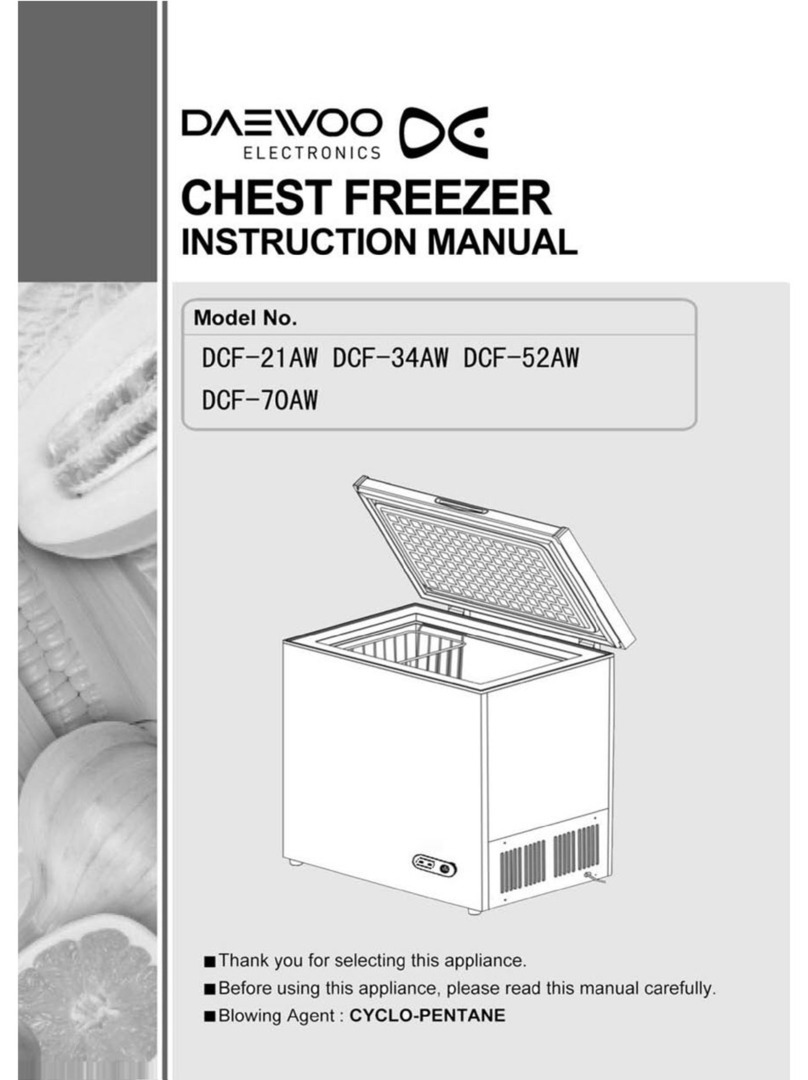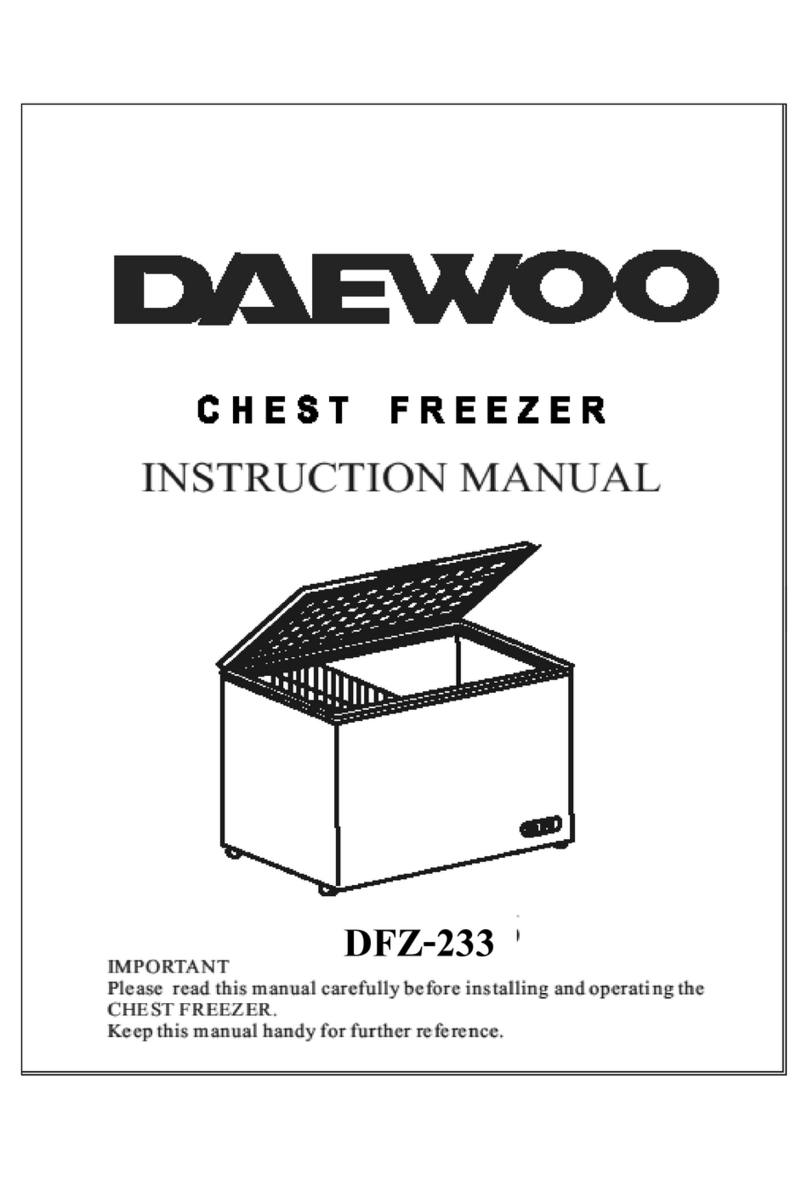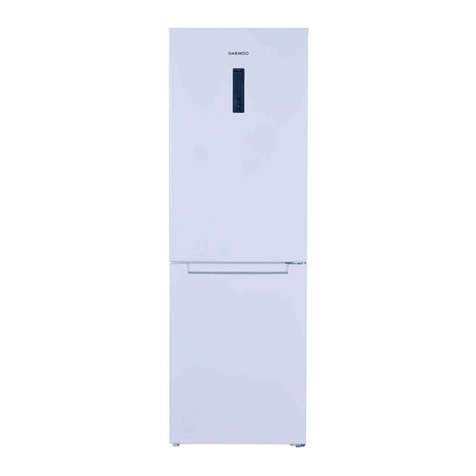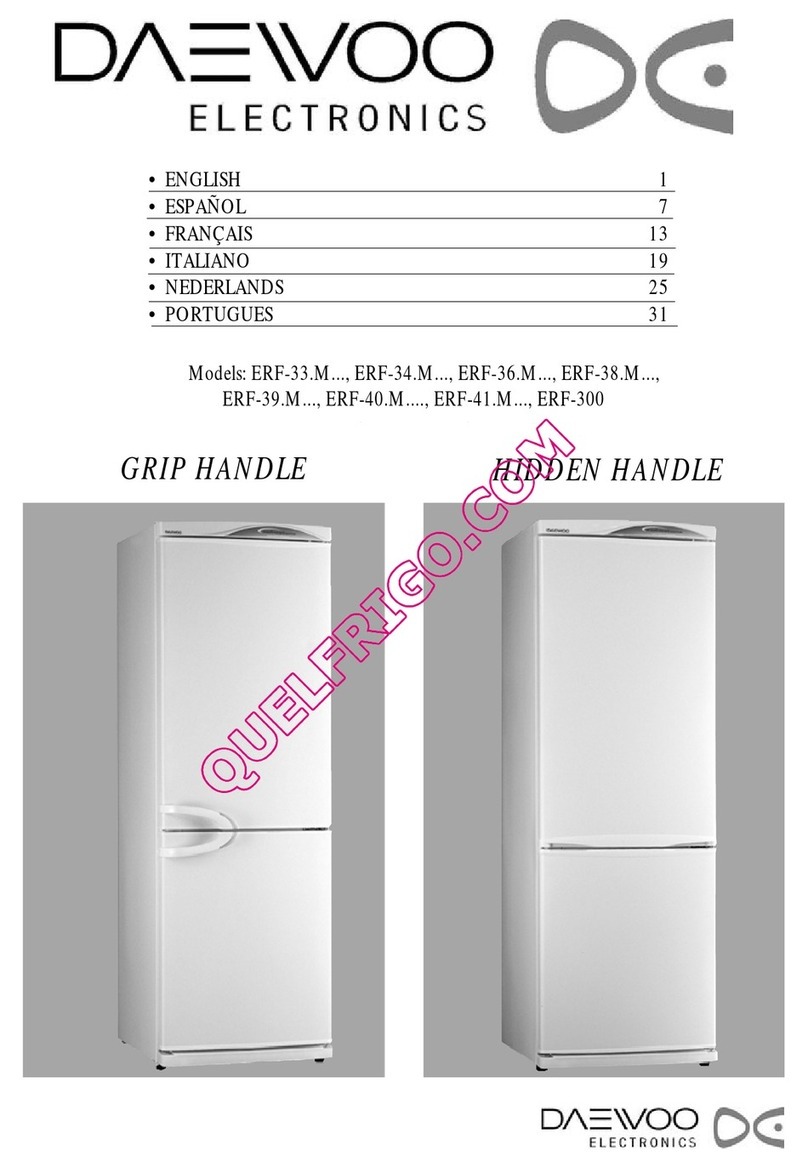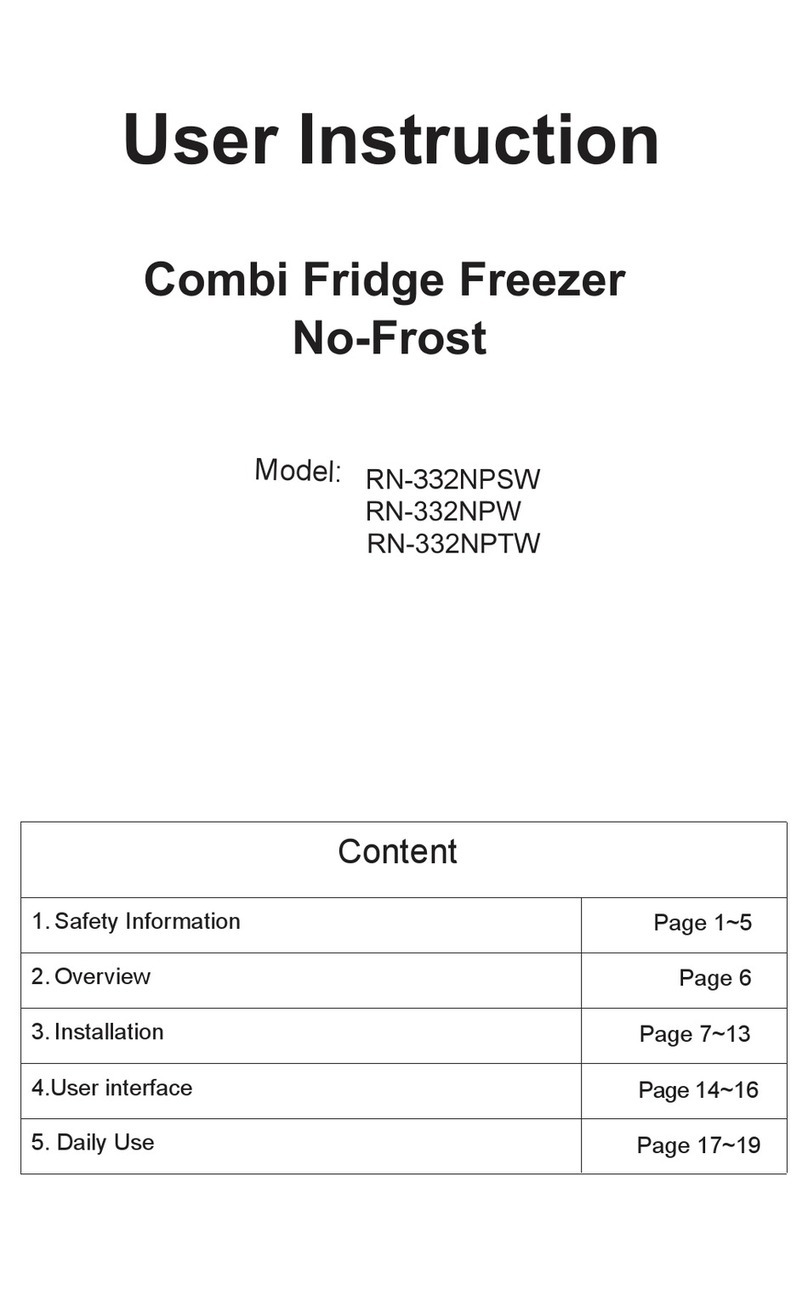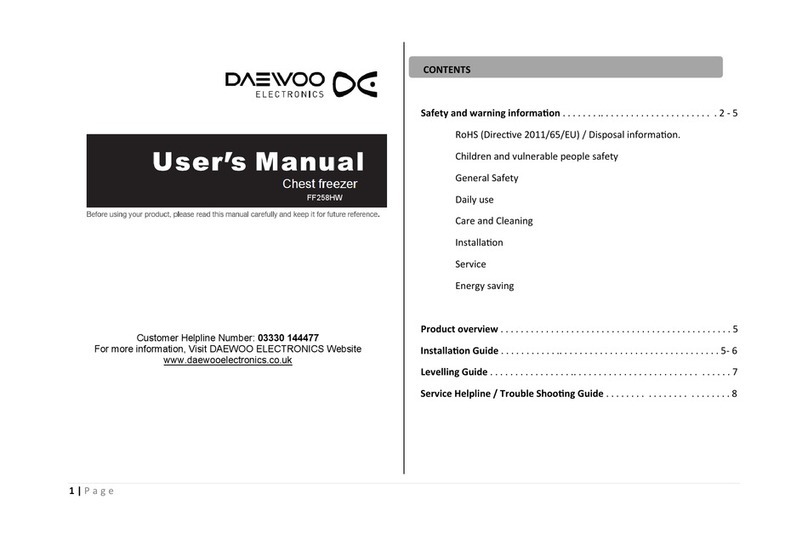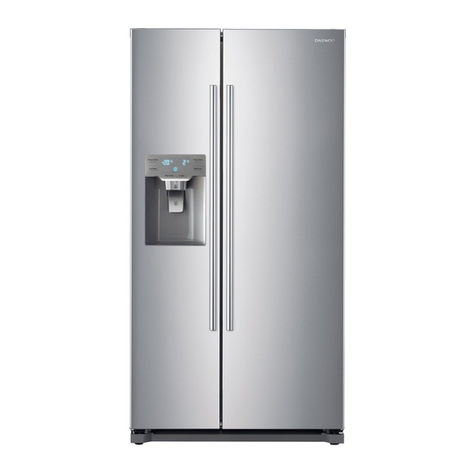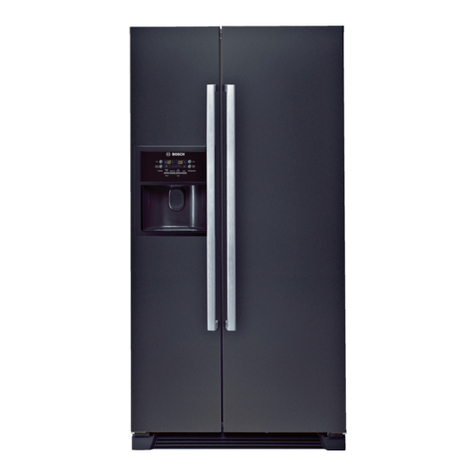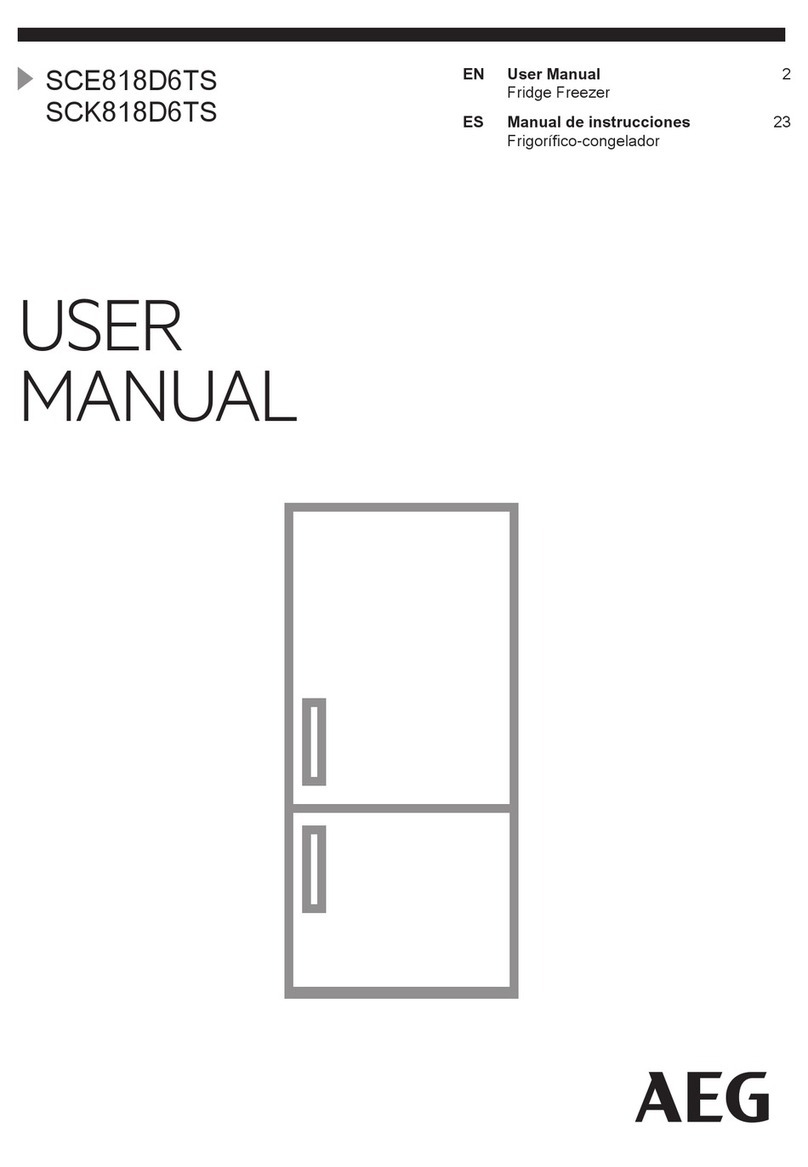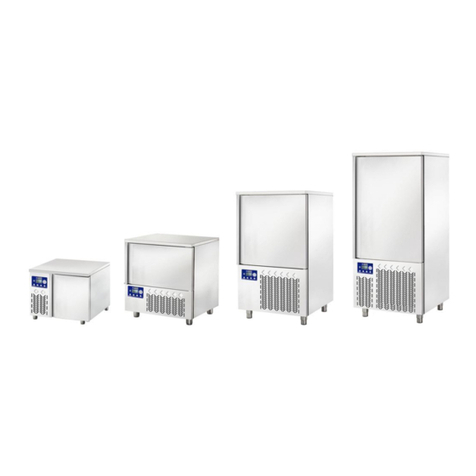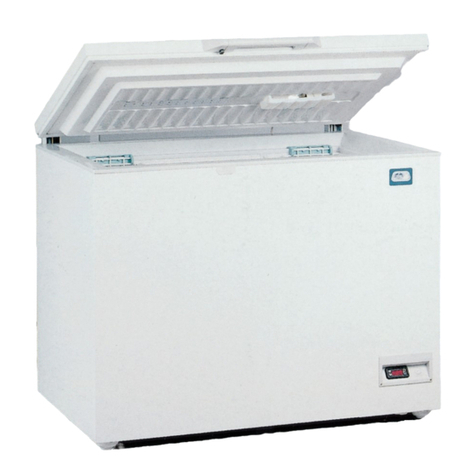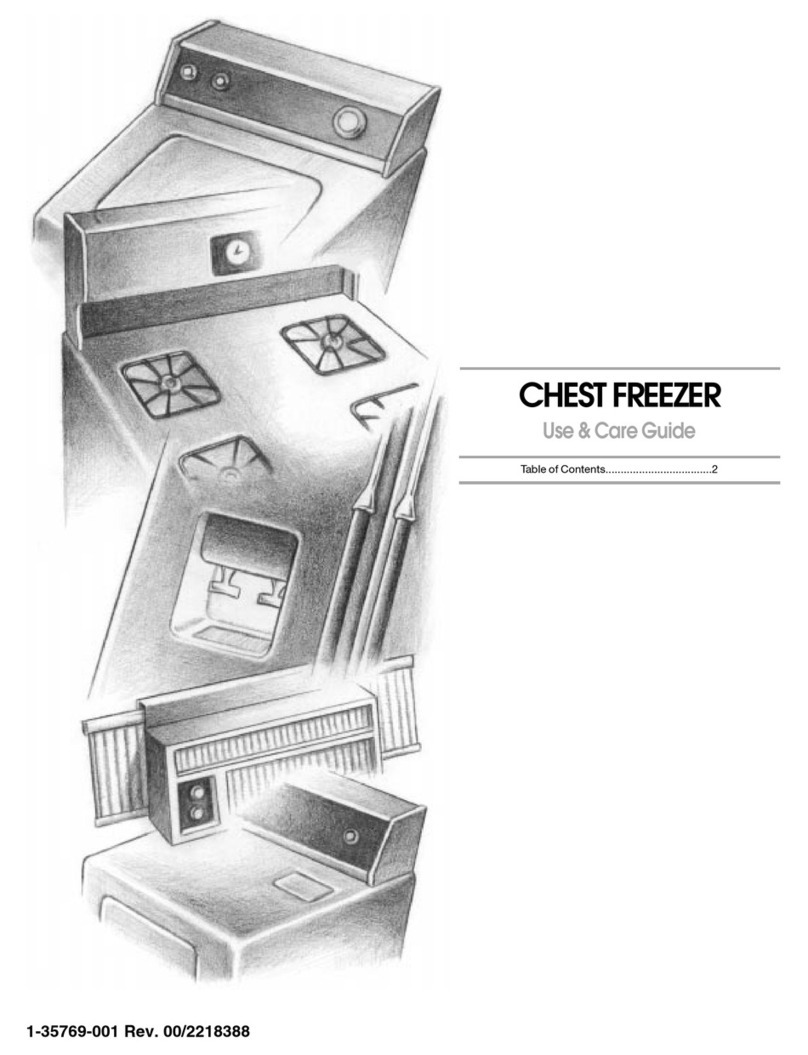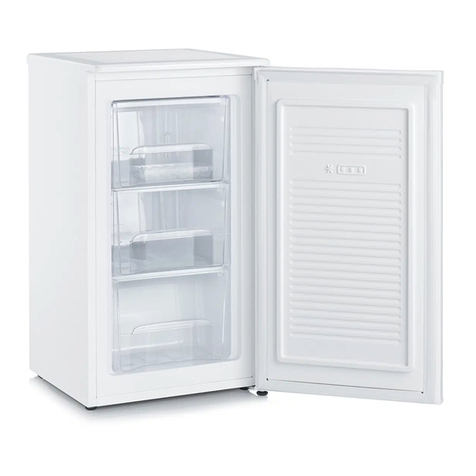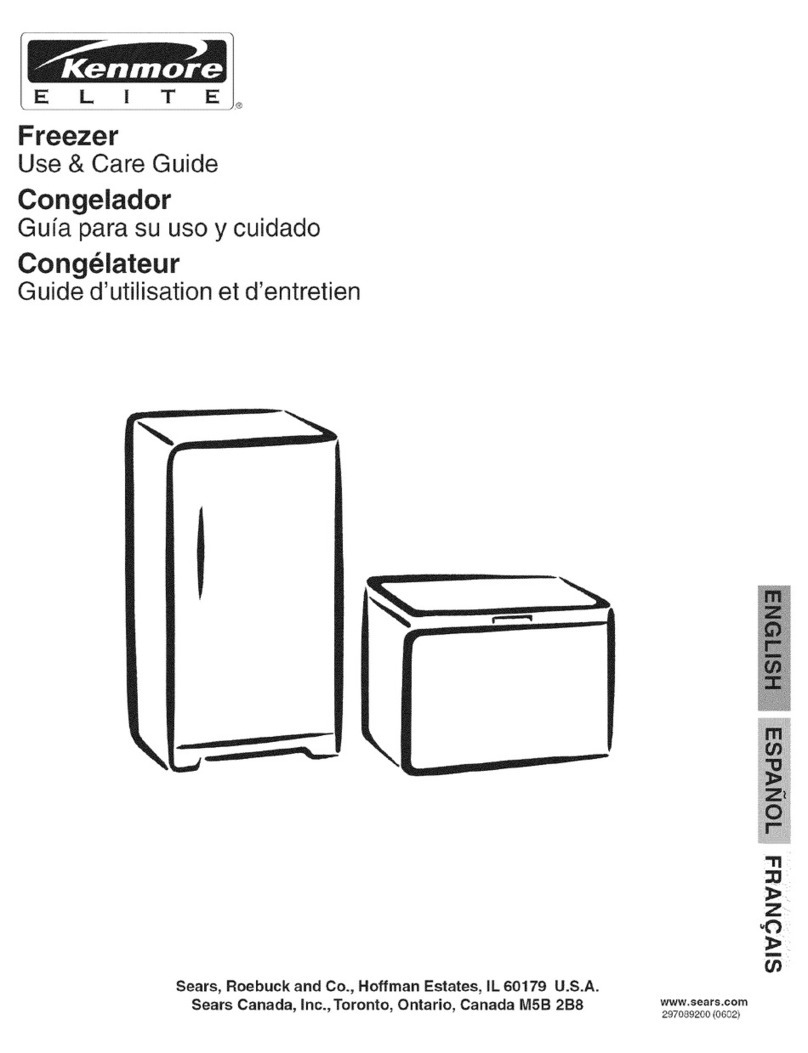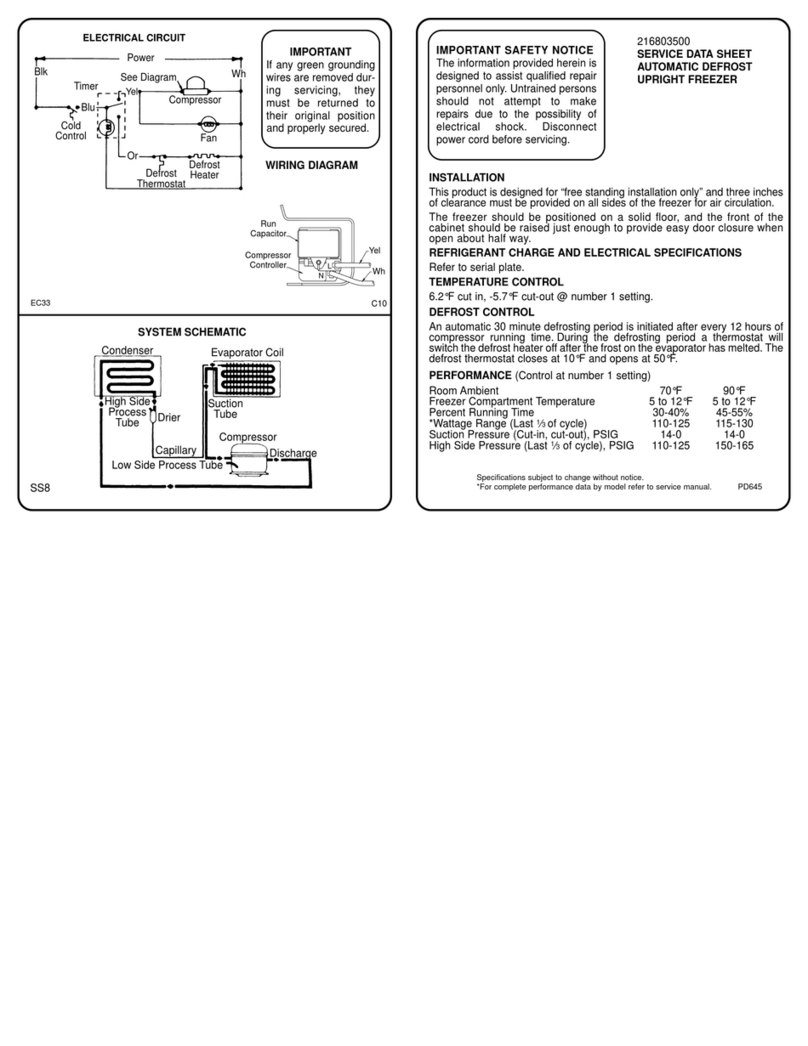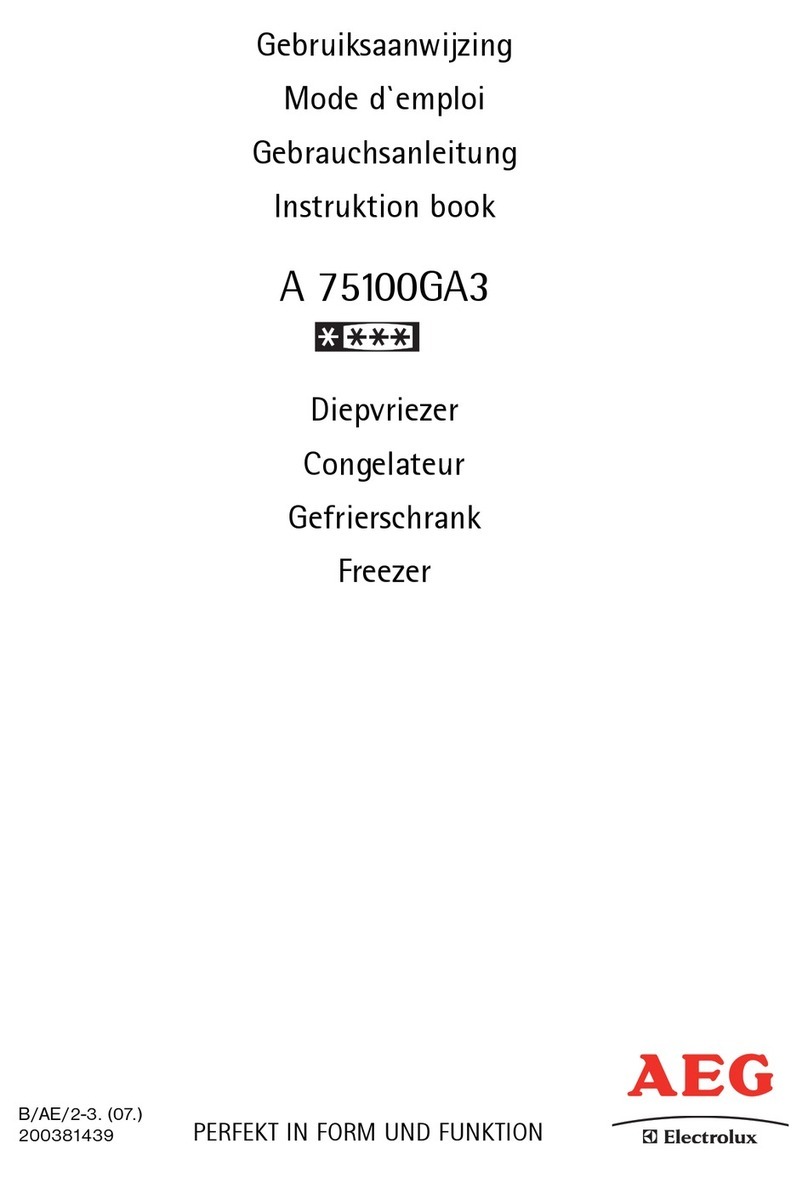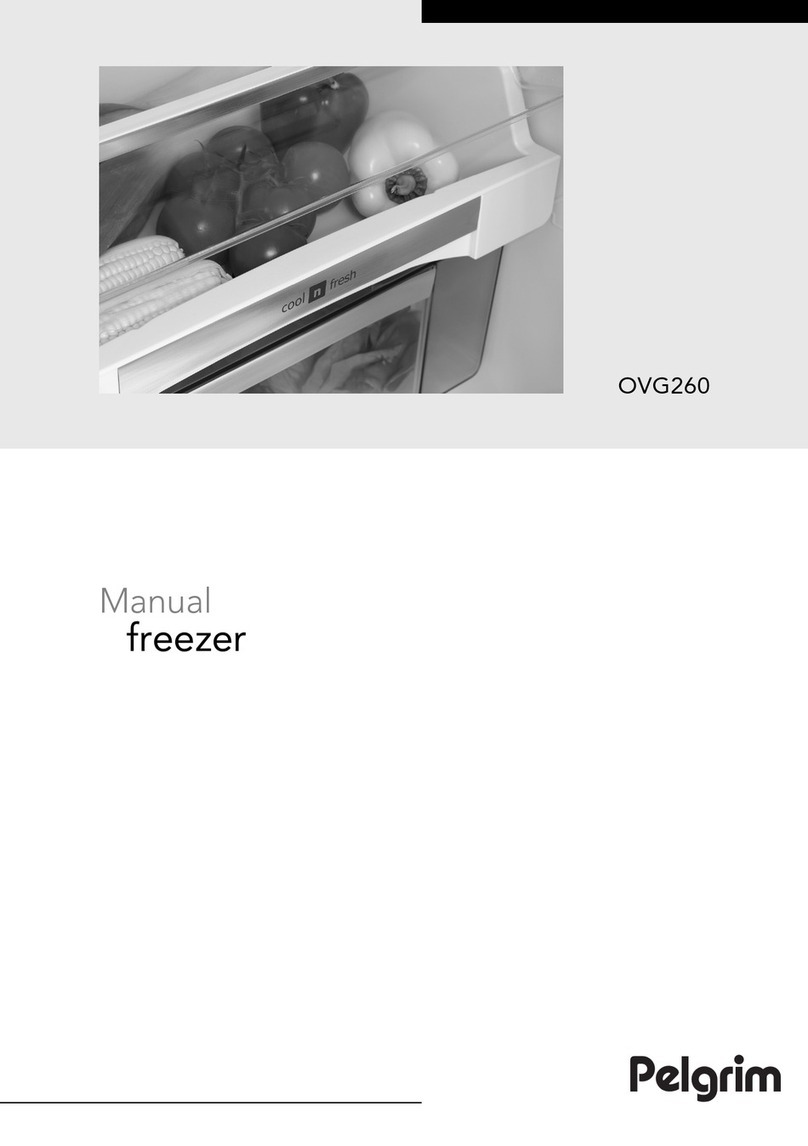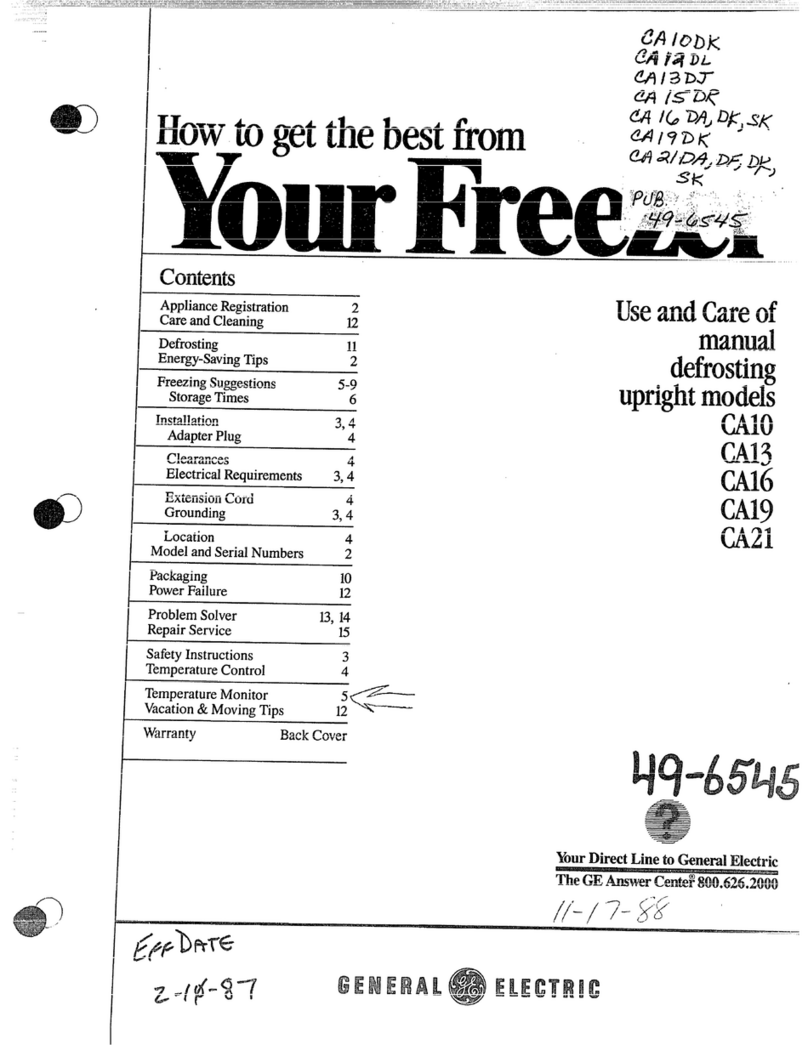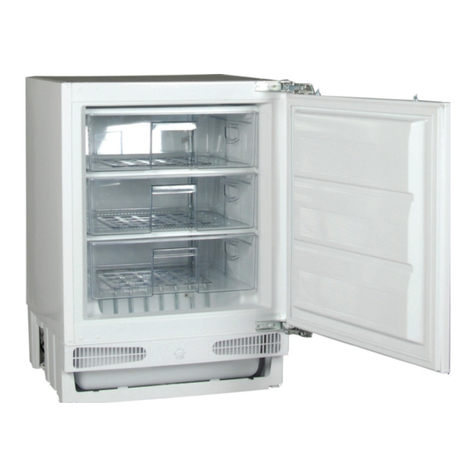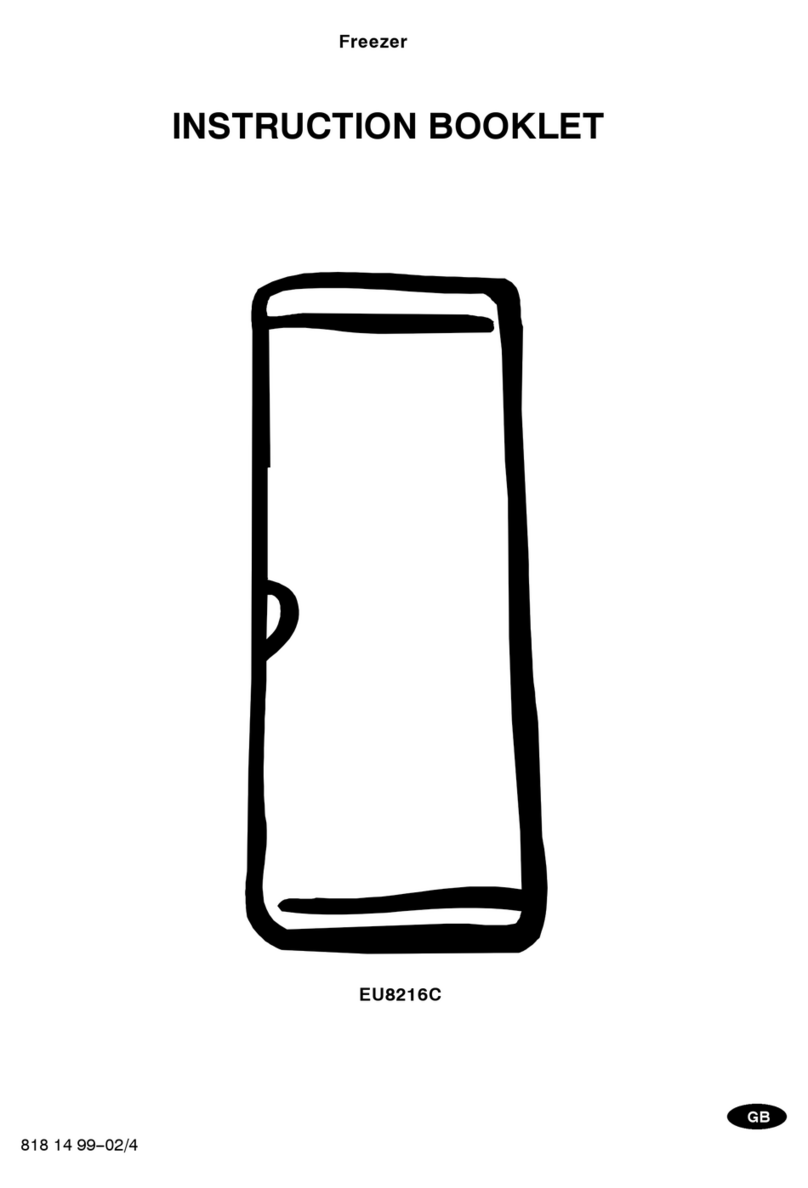Daewoo RN-171NB User manual

E-1
Model No
RN-171NB
RN-171NS
RN-171NW
RN-172NB
RN-172NS
RN-172NW
DAEWOO FROSTFREE FRIDGE FREEZER
AD241-2a(영)_DESUK.indd 1 2012-06-01 오후 2:39:54

This appliance contains a certain amountofisobutane refrigerant (R600a)a natural gas with high
environmental compatibility that is, however, also combustible.
when transporting and installing the appliance, care should be taken to ensure that no parts of
the refrigerating circuit are damaged.
Refrigerant squirting out of the pipes could ignite or cause an eye injury. If a leak is detected,
avoid any naked flames or potential sources of ignition and air the room in which appliance is
standing for several minutes.
• In order to avoid the creation of a flammable gas-air mixture if a leak in the refrigerating circuit
occurs, the size of the room in which the appliance may be sited depends on the amount of
refrigerant used.
The room must be 1m³ in size for every 8g of R600a refrigrant inside the appliance. The amount
of refrigerant is shown on the identification plate inside the appliance.
• Never start up an appliance showing any signs of damage. lf in doubt, consult your dealer.
SAFETY WARNING (R-600a Models Only)
RoHS (Directive 2011/65/EU) Compliant
This product is environmentally sound and sustainable free fromPb, Cd, Cr+6,
Hg, PBBs and PBDEs restricted in accordance with the Directive.
Disposal of Used Electrical & Electronic Equipment
The meaning of the symbol on the product, its accessory or packaging indicates that
this product shall not be treated as household waste.
Please, dispose of this equipment at your applicable collection point for the Contains
fluorinated greenhouse gases covered By the Kyoto Protocol and is hermetically
sealed.
Recycling of electrical & electronic equipments waste. In the European Union and Other European
countries which there are separate collection systems for usedelectrical and electronic product.
By ensuring the correct disposal of this product, you will help prevent potentially hazardous to the
environment and to human health, which could otherwise be caused by unsuitable waste handling
of this product.
The recycling of materials will help conserve natural resources.
Please do not therefore dispose of your old electrical and electronic equipment with your household
waste. For more detailed information about recycling of this product, please contact your local city
office, your household waste disposal service or the shop whereyou purchased the product.
AD241-2a(영)_DESUK.indd 2 2012-06-01 오후 2:39:54

E-1
WARNING / SAFETY PRECAUTIONS
To avoid any risk of personal injury, material damage or incorrect use of the appliance, be sure to observe the
following safety precautions. (After reading these owner’s instructions, please keep them in a safe place for reference).
Remember to hand them over to any subsequent owner.
WARNING
Do not plug several appliances into the same sockets.
• This could cause overheating and the risk of re.
Keep the power plug away from the rear of the fridge / freezer.
• A damaged power plug may cause re due to overheating.
Do not directly spray water inside or outside the fridge / freezer.
• There is a risk of re or electric shock.
Do not spray water inside or outside the fridge / freezer.
• There is a risk of explosion or re.
Do not bend the power cord excessively or place heavy articles on it.
• This constitutes a re hazard. If the power cord is damaged, have it replaced immediately by the manufacturer, its service agent
or a similarly qualied person.
Do not insert the power plug with wet hands.
• You may receive an electric shock.
Do not put a container lled with water on top of the appliance.
• If the water spills on to any electrical parts, it may lead to re or electric shock.
Do not install the fridge / freezer in a damp place, where it could be splashed with water.
• Incorrect insulation of the electrical parts may cause an electric shock or re.
Do not store volatile and ammable substances in the refrigerator.
• The storage of benzene, thinner, alcohol, ether, LP gas or other such substances may cause an explosion.
Do not disassemble, repair or alter the appliance.
• It may cause re or abnormal operations, which may lead to injury.
Pull the power plug out of the socket before replacing the interior light in the refrigerator.
• Otherwise, there is a risk of electric shock.
• Only the customer service may change the power cord and carry out any other repairs. Improper Installations and repairs may
put the user at considerable risk.
Be sure to earth the appliance.
• Otherwise, it may cause material damage and electric shock.
If you wish to dispose of the fridge / freezer, throw it away after removing the door or its seals.
• In this way, it is not possible for a child to remain trapped inside it.
Keep ventilation openings in the appliance enclosure or in the built-in structure, clear of obstruction.
Do not use mechanical devices or other means to accelerate the defrosting process, other than those recommended by
the manufacturer.
Do not damage the refrigerant circuit.
Do not use electrical appliances inside the food storage compartments of the appliance, unless they are of a type
recommended by the manufacturer.
WARNING
Indicates that a danger of death or serious injury exists
CAUTION
Indicates that risk of personal injury or material damage exists
AD241-2a(영)_DESUK.indd 1 2012-06-01 오후 2:39:54

E-2
CAUTION
INSTALLATION
INSTALLING THE FRIDGE / FREEZER
1. Allow an adequate space and install the fridge/freezer on afirm, level floor.
•If the appliance is not level, there may be unusual noises and poor cooling.
2. Clean the fridge/ Freezer.
•Wipe and clean the inside and outside of appliance with a damp cloth.
3. Plug the fridge/ freezer into awall socket used exclusively by this appliance.
•This appliance must be properly earthed.
4. Place the food in the fridge/ freezer.
•It is recommended that you wait for the appliance to cool for 3~4 hours before storing
food in it.
5. keep the sufficient space between refirgerator and wall.
•Side : over 6cm, Top : over 30cm, Back : over 20cm.
- Performance can be worse and electricity charges can be expensive
if space is too narrow.
6. The electrical plug must be accessiblewithout moving the set.
7. For ambient temperature below 10°C, the perfect performance ofour refrigerator can notbe achieved.
Do not store too much food in the appliance.
•When you open the door, an item may fall out and cause personal injury or material damage.
Do notputbottles or any kind ofglass in the freezer.
•The container may break and cause personal injury.
If the wall socket isloose, do notinsert the power plug.
•It may cause electric shock or fire.
Do notdisconnect the power cord bypulling on it.
•You may disconnecta wire and cause a short circuit.
Do not store article on top of the appliance.
•When you open or close the door, the articles may fall and cause personal injury or material damage.
Do not store pharmaceutical products, scientific material orother temperature-sensitive products in the refrigerator.
•Products that require strict temperature controls must not be stored in the refrigerator.
Do notlet a child hang from the door. Do not touch any containers and food in the freezer with wet hands.
•It may cause frostbite.
Remove any foreign matter from the power plug pins.
•Otherwise, there is a risk of fire.
Do notinsert yourhand into the bottom area of appliance.
•Any sharp edges may cause personal injury.
After unplugging the appliance, wait for at least five minutes before plugging it again to the wall socket.
•Abnormal operation of the freezer may cause material damage.
If the appliance isnotbeused for a long period of time, pull out the power plug.
•
Any deterioration in the insulation may cause fire.
Do notlet children touch orplay with the control panel on the frontof the appliance.
•Do not allow children to play with this appliance.
•Do not stand or lean on the base panel, pull-outparts, door and so on.
•Repairs and maintenance of the appliance should only be performed by a qualified technician. Incorrect repairs by an
unqualified person are a potential source of danger that may have critical consequences for the user of the appliance.
•Never put ice cubes or ice lollies straight from thefreezer into your mouth. (The low temperature may cause “coldburns”.)
CAUTION
The refrigerant used in fridge / freezers and the gases in the insulation material require special disposal procedures.
Ensure that none of the pipes on the back appliance are damaged prior to disposal.
AD241-2a(영)_DESUK.indd 2 2012-06-01 오후 2:39:54
Over 6 cm
Over 30 cm
Over 20 cm

E-3
WARNING
Use of an earthed socket exclusively
For the appliance :
•If you are using a socket with an earthed terminal, you do not require
a separate earthed connection.
Use ofanon-earthed socket :
•Connect the “earthed wire” to the steel plate and bury it at depth of
at least 25cm in the ground.
25cm
LEVELING
If the front of the appliance is slightly higher than the rear, the door can be opened and closed more easily.
1. The appliance tilts down to the left.
Turn the left adjusting leg in the direction of the arrow until the appliance is lever.
2. The appliance tilts down to the right.
Turn the right adjusting leg in the direction of the arrow until the appliance is lever.
AD241-2a(영)_DESUK.indd 3 2012-06-01 오후 2:39:57

E-4
ABOUT THIS PRODUCT
This is designed for domestichousehold use only.
Use the 2.5-star freezer compartment
- to freeze fresh and cooked foods,
- to store deep-frozen and frozen product,
- to make ice-cubes.
Use the refrigerator compartment
- to store fresh foods,
- to cool drinks.
The freezer and refrigerator compartmentdefrost automatically.
Owing to cool air circulation (multi-airflow system) an even temperature is maintained on every shelf of the refrigerator
compartment.
The electronic control panel or control knob enable you to control the temperature of refrigerator compartment.
BEFORE CONNECT ING TO THE MAINS
1. Wait 2 hours after delivery before you connect the appliance to the power supply, in order to ensure trouble-free operation.
2. Check the productlabel which locates refrigerator compartmentwall for voltage, refrigerant and other information.
3. The socket should be easily accessible and not directly behind the appliance.
4. Electrical connectionsmust be made in accordance with local regulations. The appliance must be earthed as described by law
(connected through a properly earthed plug and socket). The manufacturer rejects all liability for injury to persons and animals
or damage to property resulting from failure to comply with this requirement.
5. A 10A fuse or one of higher value must be used in the socket circuit.
6. If the appliance plug and the wall socket are incompatible, the socket must be replaced by a qualified electrician.
7. If the supply cord is damaged, it must be replaced by the manufacturer, his service agent or a similarly qualified person
8. Do not use extension leads or multiple adapters, etc.
PREPARING THE FRIDGE / FREEZER
To Prepare your appliance for use and check that itis running correctly, take the following steps.
1. Install removed all shelves and compartmentsduring transport in the correct positions.
2. Clean the fridge / freezer and accessories to remove any dust that accumulated during packing and shipping.
3. The interior light should be turned on when the refrigerator door’sopened.
4. Set the temperature control to the coldest temperature and let the refrigerator operate for one hour. The freezer should
get slightly chilled and the motor should run smoothly with a soft hum and no noise. Your fridge / freezer is operated by a
compressor which switches “on and off”to maintain the internal temperature. When compressor is new, it requires running in
for a period of up to five months. During this period, it may be slightly noisy. This is quite normal and does not represent a fault.
5. Store food once the temperature in the refrigerator is sufficiently low. It takes a few hours after starting the refrigerator to reach
the proper temperature.
If the appliance does not operate correctly, check the electricity supply. If the problem persists, contactyour dealer.
6. Allow the appliance to stand for 2 hours before plugging in.
7. A whooshing noise can sometimes be heard when first installed. Don'tworry the cases will soon settle.
CE
This producthas been designed, constructedand marketed in accordance with EEC directives 2006/95/CE, 2004/108/CE, and
96/57
Please read this manual carefully to ensure maximum satisfaction from your appliance. Keep the manual in a safe place for
future reference. For drawings referenced in the text below, see flap at back of the manual.
AD241-2a(영)_DESUK.indd 4 2012-06-01 오후 2:39:57

E-5
DESCRIPTION OF YOUR REFRIGERATOR
1. NAME OF PART
2. FUNCTION
AD241-2a(영)_DESUK.indd 5 2012-06-01 오후 2:39:58
Lamp
Shelves Multipurpose
Pocket
R-Knob
Control
Big Pocket
F-Knob
Control
Refrigerator
Case
Freezer
Case
Shelves : Use this shelf for storing refrigerated food.
Refrigerator Case : Use this case for keeping the food long-time.
Freezer Case : Use this case for making the ice and storing frozen food.
Multipurpose Pocket : Use this pocket for storing short bottled food, packed drinks etc.
Big Pocket : Use this pocket for storing long bottled food, drinks and water etc.
Ice Tray

E-6
DISCONNECTION
NOTE: Electrical disconnection: remove the plug from the mains, or (if applicable) disconnect the two-polecircuit breaker
upstream from the socket.
PROTECTING THE ENVIRONMENT
- The packaging may be completely recycled, as confirmed by the recycling symbol; follow local disposal regulations.
- The appliance is manufactured form reusable materials.
- When you decide to scrap this product,please check the cable to be disconnected from the mains. Then cut off the cable and
dispose of the product according to local waste disposal laws.
- This productis free of CFC’s (cooling circuit contains R-600a as a refrigerant)
IMPORTANT
1. Although this productwas carefully checked before packing. Please check the product for damage and for correct closing
of the doors. Complaints must be reported to your retailer within 24 hours of delivery.
2. Installation instructions(8 drawings below)
3. Keep potentially hazardous packing materials (plastic bags, etc.) out of reach of children to prevent the risk of trapping and
suffocation.
Keep room dry and well
ventilated.
Clean interior with a damp
cloth.
Keep more than 30cm
30cm
distance space at the top
for ventilation.
Best room temperature
Range- +16°C to 32°C
32
Wait 2 hours before
connecting tothe mains
2 hours
GENERAL RECOMMENDATION
Check for damages and correct
closing of the doors.
No glass bottles in the freezer
compartments.The bottles might
burst.
Not in the vicinity of a heat
source.
Keep air vents open.
AD241-2a(영)_DESUK.indd 9 2012-06-01 오후 2:40:00

E-7
Ice cubes and ice lollies
straight out of the freezer are
too cold for consuming. They
may cause ‘cold’burns.
Do not allow children to play
or hide in the refrigerator to
prevent the risk of trapping
and suffocation.
Always unplug before cleaning
and servicing.
If the power cord is damaged,
it must be replaced by the
manufacturer or its service
agent or a similarly qualified
person in order to avoid a
hazard.
HOW TO USE THE REFRIGERATOR COMPARTMENT AND FREEZER COMPARTMENT
Connect the lead to the main (at least wait 2 hours after delivery; refer to section “Before connecting to the mains”)
Food can be stored after 3 to 4 hours of cooling.
- The interior light switches on when The door is opened.
- The compressor operates and starts cooling.
[REFRIGERATOR TEMPERATURE CONTROL]
OBSERVE AMBIENT TEMPERATURE
This refrigerator is designed to operate in ambient temperature specified by its category, which marked on the rating plate.
NOTE
Internal temperature may be affected by such factors as the location of the refrigerator, ambient temperature and frequency of
door opening.
Climatic category Ambient temperature from…to
SN +10°C to +32°C
N +16°C to +32°C
ST +16°C to +38°C
T +16°C to +43°C
AD241-2a(영)_DESUK.indd 10 2012-06-01 오후 2:40:01
- Warmer than "Med" position
(approx. 6°C)
- Suitable storage temperature for fresh food
at an ambient temperature of 16°C to 32°C
(approx. 3°C)
For ordinary use
- Colder than "Med" position
(approx. 1°C)

E-8
[FREEZER TEMPERATURE CONTROL]
NOTES ON FREEZING AND STORAGE
1. Follow storage times indicated by the frozen food manufacturer. Make sure that the packaging is undamaged.
2. Save energy : minimize opening of the door by storing identical food items together.
3. Items suitable for freezing : meat, poultry, fresh fish, vegetables, fruits, dairy products,bread, baked goods, pre-cooked
meals.
4. Items not suitable for freezing : lettuces, radishes, grapes, whole apples and pears, fatty meats.
5. When you freeze food yourself, pack it in appropriate quantities. In order to freeze food right through do not exceed the
following quantities to best preserve the quality:
- fruits and vegetables : up to 1kg,
- meat : up to 2.5kg.
6. Blanch vegetables after washing and cuttingthem.
(2-3 minutes in boiling water; then quickly cool them down in cold water. When you use a steamer or microwave oven, follow
the operating instructions).
7. Keep packs dry in order to avoid them freezing together.
8. Freeze fresh food separately form already frozen foods.
9. Do not salt or season fresh food or blanched vegetables before freezing. Other foods may be lightly salted or seasoned. The
intensity of flavor of some spices can change.
10. Use materials or containers specially suitable for freezing in order to avoid loss of quality.
11. Write contents and date of freezing on the packs.
Do not exceed the storage time indicated in order to preserve quality.
12. Do not freeze bottles or cans with carbonated drinks, cause they might burst.
13. Take out as much food as is immediately required for thawing. Prepare it as soon as possible after thawing.
- Warmer than "Med" position (approx.
-18°C, When R-Knob Control is Med)
Frozen fuction can be weakened when the ambient temperature is 5 degrees or less. Please change the installation location.
Inner temperature of refrigerator might be changed depending on amount of food, installation location. etc.
- Suitable storage temperature for frozen food
(approx. -21°C, When R-Knob Control is
Med) For ordinary use
- Colder than "Med" position (approx.
-24°C, When R-Knob Control is Med)
WHEN PURCHASING FROZEN FOOD
1. Make sure that the packaging is undamaged (damage may have caused the food to deteriorate). Bulging packs or packs
which are marked with liquid stains could have been improperly stored and may have been partially thawed.
2. Leave frozen food purchases until last and transport the items in insulated bags.
3. Place the items in the freezer as soon as possible.
4. Do not refreeze partially thawed food. Consume it within 24 hours.
5. Observe the date of consumptionand storage information.
AD241-2a(영)_DESUK.indd 11 2012-06-01 오후 2:40:01

E-9
CLEANING
1. Always disconnectthe appliance from the mains supply.
2. Do not use abrasives. Periodically clean with a sponge dampened in lukewarm water. A neutral pH detergent may be used.
Rinse and dry with a soft cloth.
3. Wipe the outside with a soft cloth dampened in water.
4. Periodically clean the front grille and the radiator at the back with a vacuum cleaner or a brush
PROLONGED DISUSE
1. Empty the refrigerator and freezer compartments.
2. Unplug the appliance from the mains.
3. Clean and dry both compartments.
4. Leave the doors open to prevent the formation of unpleasant odors.
AFTER SALES SERVICE
Before contactingour After Sales Service Department:
1. Try to remedy the problem (please read section “troubleshooting guide”).
2. Restart the appliance to check whether the fault repeats. If the malfunction persists, switch off the appliance and try again after
an hour.
3. If the malfunction still persists, then contactour Customer Service, specifying:
- the nature of the problem,
- the appliance model number,
- your full address, telephone number and area code.
NOTE : Door opening direction changes carried out by our Customer Service are not covered by the terms of guarantee.
TROUBLESHOOTING GUIDE
1. The appliance does not work. Check:
- power failure,
- properly inserted plug,
- (if applicable) connectionof the two-polecircuit breaker,
- damage to the mains lead,
- correct setting of the temperature controls.
2. The temperature inside the compartmentsis not low enough, Check for:
- closure of the doors,
- installation near a heat source,
- correct setting of the refrigerator / freezer control knob,
- inhibited air circulation.
3. The refrigerator compartmenttemperature is too low. Check for:
- correct setting of the temperature controls.
4. The internal light does not work. Refer to point 1 and then:
- unplug the appliance from the mains.
- check the bulb and replace if necessary (max.25W)
- to change the lamp, first remove the windowof the lamp by pulling upper part forward.
- take out the lamp and replace it for a new one.
- finally set again windowlamp on its place.
AD241-2a(영)_DESUK.indd 14 2012-06-01 오후 2:40:01

E-10
FAQ
Q: My refrigerator isnot cold enough?
A: •Ensure the temperature is not set to low;
•Ensure the refrigerator is not in direct sunlight or is close to a heat source such as a radiator.
The refrigerator works at its best when the ambient temperature is between 16°C and 32°C;
•Ensure there is sufficient space (at least 10cm’s) between the refrigerator and the wall behind.
Q: Food in the fridge compartment is freezing?
A: •Ensure the temperature is not set to strong;
•Ensure the ambient temperature is greater than 5°C.
•Foods can be frozen if the ambient temperature is below 5°C;
•Ensure foods with high water content are not stored close to the cold air spout.
Please store these types of foods towards the front of the refrigerator.
Q: The refrigerator is making a sound noise?
A: •Ensure the refrigerator is positionedon a level, even floor;
•Ensure there is sufficient space (at least 10cm’s) between the refrigerator and the wall behind;
•Ensure no foreign objects are touching the refrigerator.
Q: What is this strong smell coming from my refrigerator?
A: •Ensure all foods are covered and wrapped;
•Ensure all pocketsand shelves are cleaned regularly (using a damp cloth).
Once smells contaminate these parts they can be difficult to remove;
•Ensure foods are not stored for too long. A refrigerator is not a permanent foods keeper.
Q: Whydoes the front and sideof my refrigerator feel warm?
A: •Pipes, known as refrigerant vessels, which are designed to contain heat are placed within the refrigerators cavity to prevent
moisture from forming on it.
Q: Whydo the doors seem sticky when opening?
A: •Generally this occurs when you close the door and reopen immediately.
Warm air rushes in which increases the pressure inside the refrigerator.
If this happens wait for a minute and then reopen.
Q: Whydoes it sound like water isflowing from my refrigerator?
A: •When the compressor starts to run or indeed when it stops the refrigerant, which makes the refrigerator cold, starts flowing
through the refrigerant vessels (pipes) which can lead to some noise.
Q: Whyhave I gotwater droplets on the back wall of my refrigerator?
A: •The refrigerator has an automatic defrosting function.
Melted water drains into an evaporation pan at the back of the refrigerator.
When the compressor runs the heat generated makes this water evaporate.
As a result you will find frost and water drops on the back wall of the refrigerator.
Q: Whyis my refrigerator humming/buzzing?
A: •This is the normal sound of the compressor and cold air circulation fans.
The sound can be greater if the refrigerator is positionedon an uneven floor.
Q: Whyisdew forming on the wall in the fridge and freezer compartments?
A: Frost or dew can occur for the following reasons:
•The ambient temperature is too high;
•The doors are left open for too long;
•Foods with high water content are being stored uncovered or unwrapped.
Q: Whyis there dew on the interiorlight cover?
A: •The light bulb will radiate heat when it is on so when the doors are opened dew can form because of the sudden difference
in temperature.
AD241-2a(영)_DESUK.indd 15 2012-06-01 오후 2:40:02

E-11
GENERAL ADVICE
•Follow packaging “bestbefore/use by”guidelines for maximum storage time.
•Keep foods covered to retain moisture and prevent flavour/odourtransfer. Plastic bags, aluminium foil and plastic stretch wrap
are ideal.
•Select chilled and frozen foods last when shopping, transport in a “coolbag”and place in the appliance as soon as possible
after arriving home.
•Avoid opening the doors unnecessarily or for longer than needed.
•Allow hot or warm food to cool down in covered containers before placing in an appliance, as placing hot food in the appliance
reduces efficiency.
•Do not use to store poisonous, flammable or dangerous substances, your appliance has been designed or the storage of edible
foodstuffsonly.
•Pack and store cooked and fresh food separately.
•Wrap raw or defrosting meat and poultry in polythene or foil and store below cooked foods and dairy productsto avoid
contaminationor drippingfood juices.
•Wrap cheeses in greaseproof paper and place in an airtight polythene bag. Bring to room temperature before consuming.
•Empty left over canned food into a covered storage container before placing in the fridge compartment.
•Position food in the fridge compartmentto allow cold air to circulate freely.
•Use the different storage zones inside your fridge compartmentto store a wide variety of food items.
•Generally speaking long term storage of foods in the freezer compartmentmeans up to 3 months but this can vary so always
follow your food supplier’s recommendations.
•Liquid filled bottles or sealed fizzy drinks must not be stored in the freezer compartmentas they may burst.
•Lollipops and water ices should not be given to children directly from the freezer. The low temperature may cause “freezer
burns”on lips.
•Store ice cream towards the top front of the freezer and remove from freezer 15-30 minutes before serving.
•Ensure food is labelled and dated before placing in the freezer.
•Once thawed, food should be cooked and eaten within 24 hours or cooked and refrozen.
•For non frost-free units defrost your freezer when the ice is between 3-5mm thick.
A thick layer of ice will increase the running costs of your appliance.
AD241-2a(영)_DESUK.indd 16 2012-06-01 오후 2:40:02
APPLIANCE PACKAGING INFORMATION
All material are environmentally sound! They can be dumped or burned at an incineration plant withoutdanger!
About the materials: The plastics can be recycled and are identified as follows:
PE : for polyethylene, e.g. the outer covering and the bags in the interior.
PS : for polystyrene foam, e.g. the pads, which are all free of chlorofluorocarbon.
The carton parts are made from recycled paper and should be disposed of at a waste-paperrecycling collectionlocation.
DISPOSAL OF OLD APPLIANCES
For environmental reasons, refrigeration appliances must be disposed of properly. This applies to your old appliance, and –at the
end of its service life- for your new appliance as well.
Warning! Before disposing of old appliances make them remove or destroy any snap or latch closures. This eliminates the
danger that playing children lock themselves into the appliance (danger of suffocation!) or place themselves into other life-
endangering situations.
Disposal :
•The appliance may not be disposed of with domestic waste or bulky refuse.
•The refrigerant circuit, especially the heat exchanger at back of the appliance, may not be damaged.
•Information concerning collectionschedulesor locations can be obtained from the local disposal authorities or town hall.
NOTICE
Ensure the fridge door closed completely because the interior light can be switchedoff although the door is not completely
closed.
NOTE : The edge of the refrigerator door and the front side of the refrigerator cabinet may be hot. This is normal and intended to
prevent the formation of condensation.
Gurgling noises etc. inside the refrigerating circuit are normal.

F-12
DIMENSIONS
AD241-2a(영)_DESUK.indd 17 2012-06-01 오후 2:40:02
Poids
Dimensions (L x H x P)
(Sans poignée)
38kg
485*1227*617 mm
This manual suits for next models
5
Table of contents
Other Daewoo Freezer manuals

Daewoo
Daewoo RN-331DPS Installation instructions
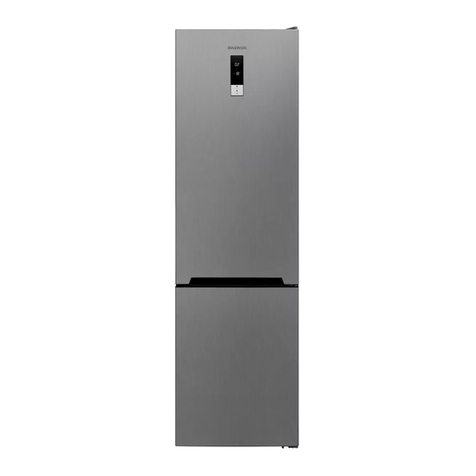
Daewoo
Daewoo RNV3810DSF User manual
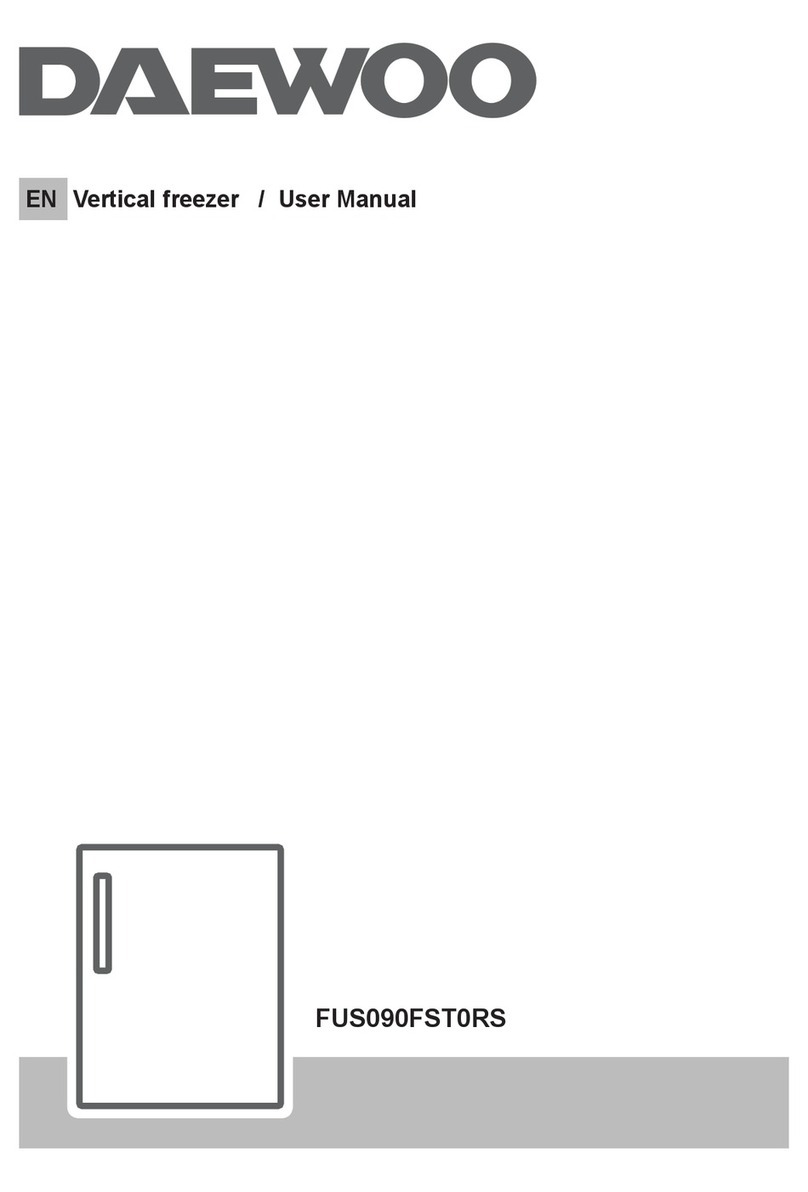
Daewoo
Daewoo FUS090FST0RS User manual
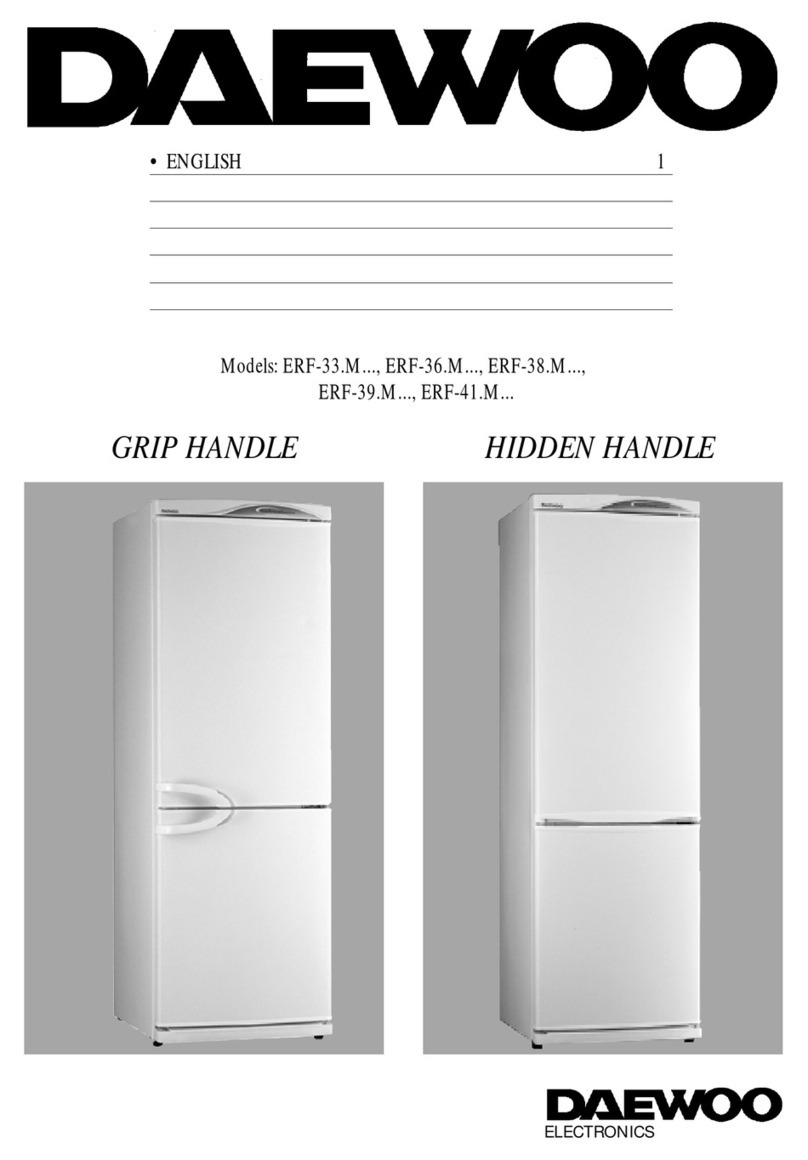
Daewoo
Daewoo ERF-36.M User manual

Daewoo
Daewoo FFN278EWR0ES User manual
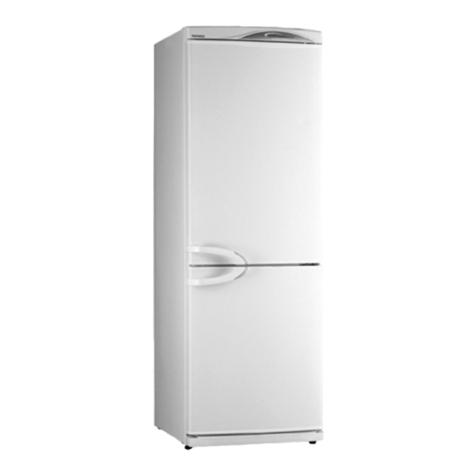
Daewoo
Daewoo ERF-40.M User manual
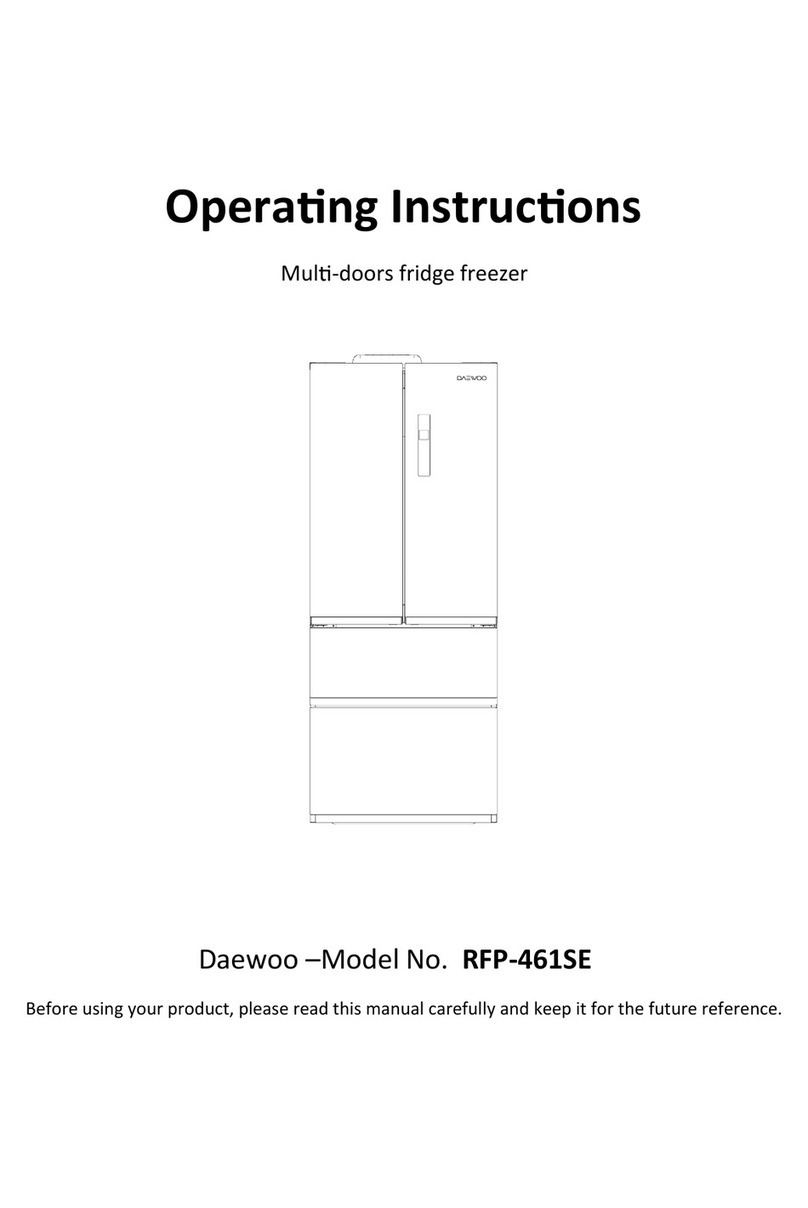
Daewoo
Daewoo RFP-461SE User manual
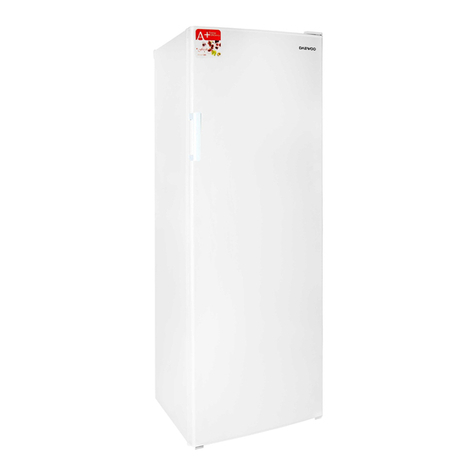
Daewoo
Daewoo FF311VP User manual
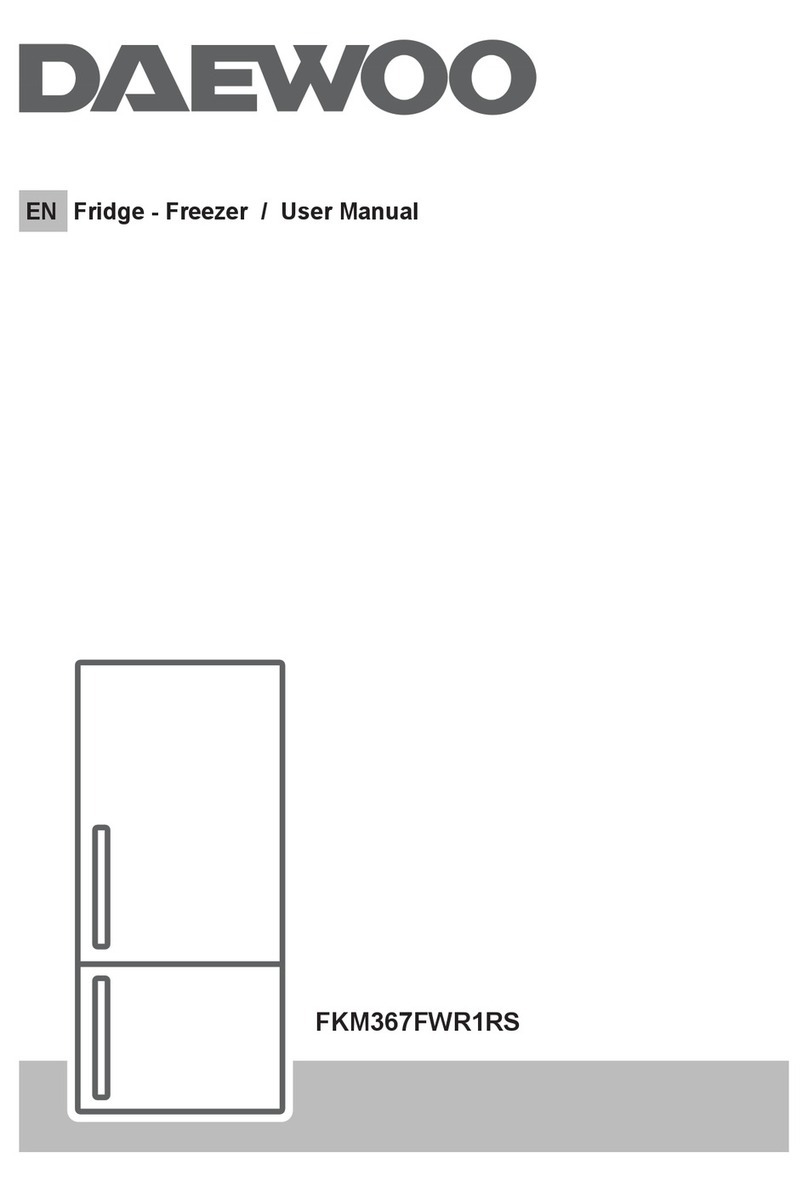
Daewoo
Daewoo FKM367FWR1RS User manual
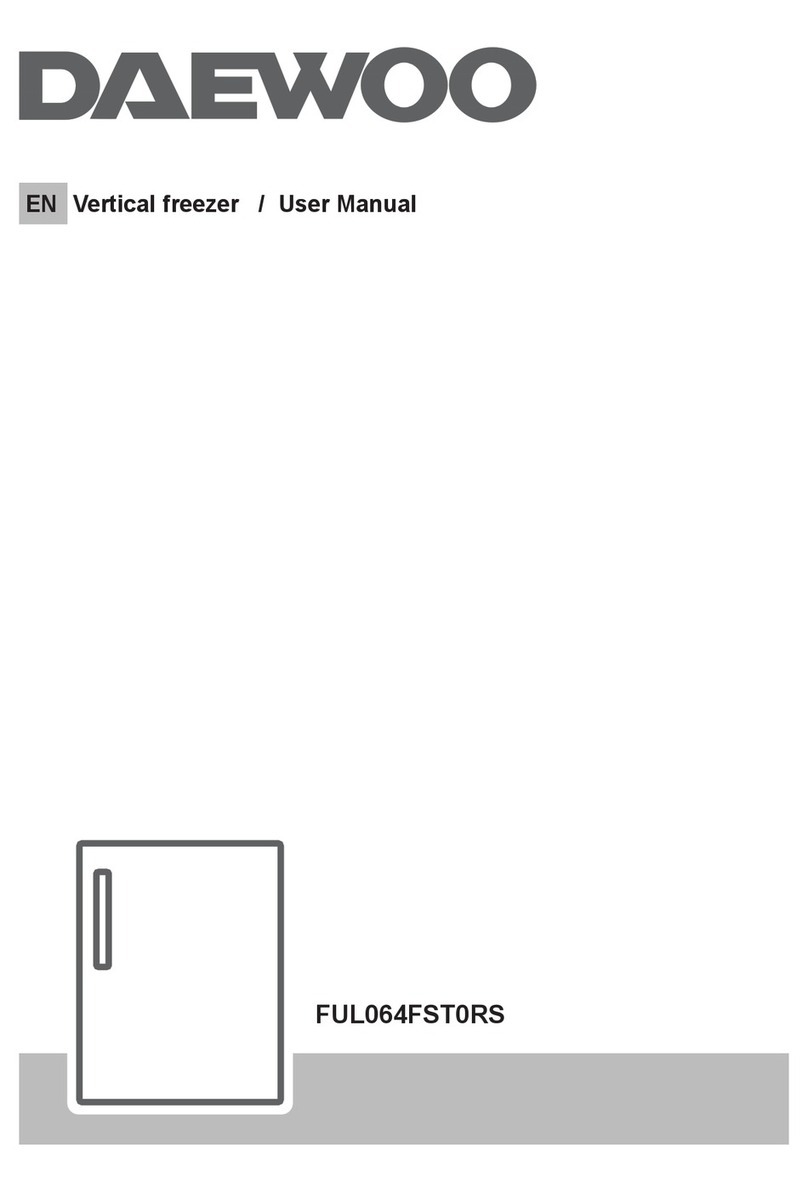
Daewoo
Daewoo FUL064FST0RS User manual
